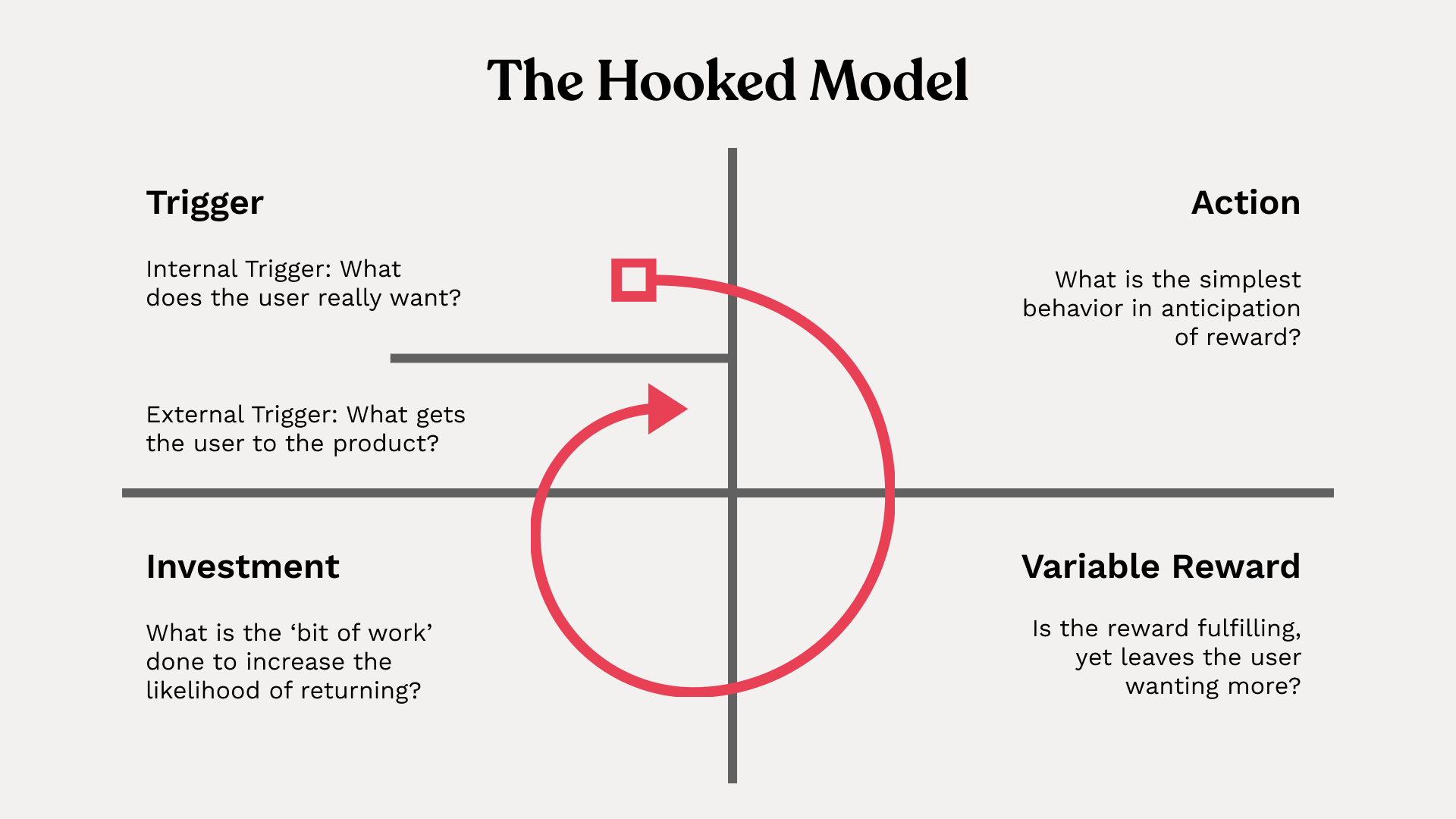Have you ever been bored and caught yourself checking Instagram just seconds after you closed it?
I’m sure you didn’t reopen it because you had an overwhelming urge to see more pics of your college roommate's lunch. You did it without thinking, like it was second nature.
If that sounds familiar, then I hate to break it to you: You have a habit.
And what’s more, that habit was built intentionally – by the people who designed your app.
In this post, we’ll dig into former Stanford Professor Nir Eyal’s Hooked Model, which breaks down the four steps product designers use to make apps (and other products) so habit-forming.
Want to keep learning?


1. It starts with a trigger
Your phone barrages you with notifications throughout the day, shooting you little reminders that it’s your old co-worker’s birthday or that your favorite pizza chain is still running a three-for-one deal.
These are called external triggers. And they’re aimed at getting you to do something – usually open the app and engage with it.
You might notice that they come at suspiciously convenient times, like when you’re waiting for the subway or are about to head home for the day.
That’s because the goal of habit-forming apps is to correlate external triggers (like a push notification) with an internal trigger – one that happens solely within your head.
Let’s say you’re feeling lonely. You might be tempted to reach out to a friend to catch up. Or maybe you’re exhausted and would really like to avoid making dinner. Those negative feelings are triggers prompting you to seek out some relief.
When the external triggers on your phone match up with your internal triggers, the app positions itself as something that’ll help put you at ease. Suddenly, you’re interested.
2. Then you perform an action
Now that the app’s gotten your attention, the next goal is to get you to perform an action.
This action might be something like scrolling through a feed, clicking an eye-catching article, or watching a new video.

If you look closely, you might notice how easy the app makes these actions. This is called reducing hurdles to action. The easier it is for you to perform an action, the more you’ll engage with the app.
For example, an app like Instagram might:
- Show you suggested posts based on your interests
- Start playing a video automatically
- Display a button that lets you click to “new posts” with one touch
3. Next, you’re rewarded
The next step in the Hooked Model is reward.
Let’s say you scrolled down a bit and saw some adorable photos of your friend’s new puppy. You scrolled further and got a quick update on that whole Kanye-Pete-Davidson-thing. And, oh snap! Now there’s a listicle ranking Star Wars bounty hunters?
As you keep going, you uncover new, interesting items with every thumb stroke. That experience is what the Hooked Model would call a reward.
Psychological rewards work by providing immediate gratification. While they take on different shapes, the most habit-forming fall into three buckets:
- Rewards of the tribe: Your friends loved your last post. Now you feel validated.
- Rewards of the hunt: You tracked down an amazing deal. Now you want to find another.
- Rewards of the self: You took the top-spot on your game’s leaderboard. Now you feel accomplished.
Rewards like these have been driving human behavior for hundreds of thousands of years. Sure, you may not be chasing down mastodons these days, but watching a viral video of that YouTuber you like dunking on that YouTuber you don’t like can still feel pretty damn rewarding.
4. Now you’re invested
Next time you go into the app, you might notice that it’s a little better than the time before. And that’s all because of the choices you’ve made.
This is what happens when you follow a new comedian on Facebook or create a Spotify playlist for your morning bike ride. Your contributions make the app more useful to you, which makes you more likely to use it – and therefore solidifies your habit.
Your continued investment also means you’re setting yourself up for fresh triggers.
When you get a notification about a like or a direct message, you’re automatically put right back at the top of the cycle — which means your app habit’s about to get a lot harder to break.
Here’s how three popular apps take you through the Hooked Model:

Want to increase stickiness in your own product? Become a Section4 member to learn from Nir Eyal and other leading minds.












